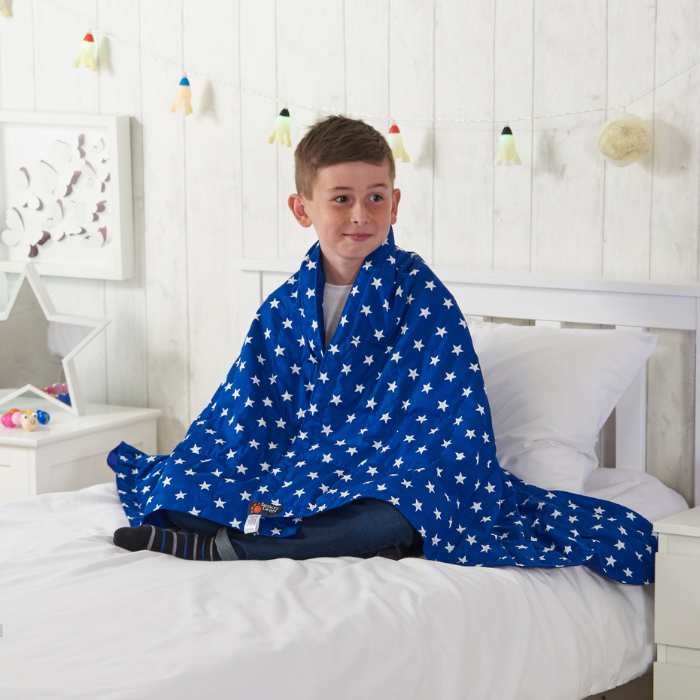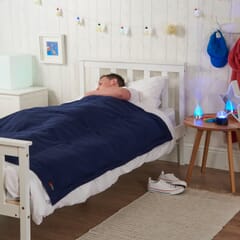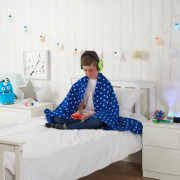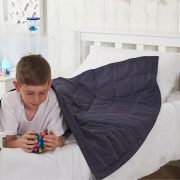Get exclusive deals you won't find anywhere else straight to your inbox.

Choosing and Using a Weighted Blanket
Where to use a weighted blanket
Weighted blankets come in different sizes and are designed to be used in a variety of ways. Typically used to help calm the body ready for a good night's sleep, they can also be used;
- To help relax after a stressful day at school or work. Try wrapping around the shoulders for deep pressure support, relieving anxiety and tension.
- Chilling on the sofa. Place across your legs or wrap around the body to provide a reassuring 'hug'.
- In a sensory den or room. Lie on the floor and place a weighted blanket over you to help with self regulation and grounding.
- At a desk. Place a smaller weighted blanket across your lap whilst working. The deep pressure can help with focus and concentration.
- In school to help reduce hyperactivity and provide comfort when over stimulated or anxious.

How to use a weighted blanket at night
Weighted blankets are most commonly used at night time. There a few key things to consider when incorporating one as part of your bedtime routine.
The most flexible blankets are those designed to be used with your child’s usual bedclothes. Using a weighted blanket over the top of your child’s duvet allows them to use their familiar bedclothes and keep change to a minimum. When you remove the weighted blanket your child will still have their normal bedding for comfort and warmth.
Blankets can be made from poly-cotton do not add much in the way of extra insulation and therefore overheating is not a common problem with these blankets. In hot weather, however, using a lighter duvet is always an option if this is likely to be an issue. Larger, duvet-size blankets are available for older children – again those with removable weights are the most flexible and user friendly.
IMPORTANT – IF you decide the leave the blanket on , the user should always be able to self-remove the blanket and the blanket should never be used as a restraint. However, most of the time they won’t want to remove it as it’s providing the deep pressure they crave!

Classroom use of weighted blankets
Smaller blankets than those designed for bedtime are available for use in other contexts, such as a school classroom. Often referred to as ‘midi’ blankets, they can be used whilst the child is sat; watching TV, reading, in the car, or as a comfort in the classroom if a child becomes over-excited or upset.
Such blankets are widely used in special education classrooms, and autism bases within mainstream schools. Where a child with ASD finds the classroom environment too overwhelming, they are offered a quiet area (often a separate sensory room) where they can sit quietly wrapped in a weighted blanket. The deep touch provided by the blanket helps to calm, relax, and re-focus the child.
Other weighted therapy products, such as lap pads and shoulder wraps, can also prove equally useful in classroom environments.
How To Choose A Weighted Blanket
Choosing the right Weighted Blanket can seem a daunting task. With so many options available it can seem like a minefield.
Firstly, where will the blanket be used? Is it for night-time only or daytime as well? Would you prefer it to be a small and portable weighted blanket?
Consider the blankets texture as this can have an effect on the overall success of the Weighted Blanket. We’ve developed a range of tactile weighted blankets at Sensory Direct to suit a variety of needs
Familiarity - Weighted Blankets that can be used on top of a duvet keep change to a minimum as you can use existing bedding.
Think about the time of year - poly-cotton blankets for example don't have too much insulation, making them a better choice for the summer.
Pick a blanket that can be easily washed. Some blankets are not easy to wash and clean, making it hard to maintain hygiene. Weighted Blankets with plastic beads can usually* be machine washed. “We’ve created our handmade weighted blankets at Sensory Direct in a way that ensures they can all be machine washed without altering their effectiveness.“
Think about longevity. Some blankets allow you to add weight as your child grows, reducing the overall cost. Look for adjustable weighted blankets that allow you to reduce or increase the weight.
Buy from a reputable supplier. There are lots of cheap alternatives about, be mindful of the quality and read the reviews
Check for product guarantees. At Sensory Direct all of our handmade weighted blankets come with a lifetime guarantee, offering you peace of mind.
Speak to your Occupational Therapist for support and advice on which Weighted Blanket to buy.

What weight blanket should I buy?
The generally accepted principle is that the weighted blanket should weigh 10% of the user’s body weight. Our research and experience has shown that this method gives a blanket that is heavy enough to be effective, but not so heavy as to be uncomfortable to use.
For example, a child that weighs 30kg, the weighted blanket should be no more than 3kg. It is recommended that the weighted blanket should not exceed 10% of the user’s bodyweight – so, for example if the child weighted 33kg then the recommended blanket weight would still be 3kg (rather than moving up to the next blanket weight of 3.6kg).
It is important to remember that is only a guide. Many parents I speak to get a little anxious if the blanket is not at least 10% of their child’s weight and some will tend to go for the next size up on the basis that their child is still growing. This tends to be an mistake and not something I would recommend, with often the heavier blanket being returned for something lighter as the child finds in too heavy and uncomfortable. Something around the 10% ratio works perfectly well for most people, but it is just a start point – if a child likes deep pressure they will be soothed by most blankets with weight in them. Our own son started using a blanket when he was 5 years old – the same blanket was still working it’s magic many years later despite him having significantly grown!

Safety and use of weighted blankets
When used as directed, weighted blankets are a completely safe and effective tool to help with sensory integration. Follow the weight guides and always consult with your Occupational Therapist.
The blanket should never be used to restrain a child, and should never cover the face. Your child should be able to self-remove the blanket, and you should remove it immediately if they show any signs of discomfort or distress.
How much do weighted blankets cost?
Weighted blankets vary in cost from about £100 to over £400; as blankets are very labour-intensive to manufacture, hence the cost.
When choosing a weighted blanket, look out for those which use high quality material and carry a quality assurance mark such as the CE mark.
Additional resources
For more help selecting a weight please read our Weighted Blankets size guide
 By Andrew Caws
By Andrew Caws
Managing Director of Sensory Direct & Parent of an Autistic Adult
February 2025









